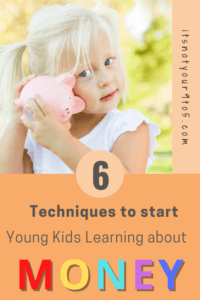Children can benefit from finance education at an early age, here are 6 techniques for young kids learning about money to help form the right habits.
A study from the University of Cambridge, “Habit Formation and Learning in Young Children,” found that money habits are formed by age 7. [Source]
Researchers share that it’s important to start basic finance education by age 3.
Children pick up money habits quickly, so giving them the right direction and guidance is crucial. Here are 6 techniques you can implement to start your kids learning about money.
1. Begin with basic currency literacy.
A study from Yale University found that children can recognize and remember coins by the age of 3.
Educate your children about the different coins and bills.
Consider teaching them about foreign currencies during vacations. This will expand their minds and help them learn more about the countries you’re visiting.
2. Create money jars
Money jars are a fun and easy way to educate your child.
You can create three types of money jars. Jars for spending, saving, and giving, cover the basic lessons of understanding how to use money.
Teach your children how to use the three jars and why they’re important.
Use the jars to separate money after birthday gifts or allowance payments. Children will learn how to save for the future.
Use the giving jar for charities. Children will learn about giving and understand how they can help others with their money. They can donate the money to local animal shelters or food pantries.
For a short version, check out the web story:
3. Use coupons
Coupons can provide an important lesson on saving.
Cut out coupons with help from your children and leave them in charge of handling the papers at the store.
According to the Children’s Financial Network, kids as young as 5 can benefit from learning how to use coupons in a store.
They will see how to save money and make wiser shopping decisions.
4. Set a money goal
Children can set a money goal to purchase a favorite toy or other items.
Money goals are an easy way to teach children financial patience. They also provide a lesson on how to save money.
It’s important to set realistic goals, so children will be motivated to stay on a savings plan. If the toy they want is expensive, it can take a while to reach their goals. Will they stay interested? Picking smaller and less expensive targets is better.
5. Go shopping
Let your children use their spending jars at the store to make purchases.
Shopping provides an easy lesson setting. How will your children spend their money? Will they use their entire jars at one store or spread them out over many shopping trips?
An outing to the local toy store also gives you the chance to discuss comparison shopping. Point out different prices on similar items and teach your children about finding inexpensive options.
Evaluating the results of the shopping trip will help them understand their choices. How will they restock their spending jars?
Holidays are a perfect opportunity for spending habits. Giving an allowance and then having the kids manage that throughout the holiday will reduce the number of times they ask for something (basically every shop you see). Instead, it’s their choice where and on what to spend the money, once it’s gone, it’s gone.
6. Selling their stuff
Selling their no longer used stuff offers another way to educate children about finances.
Car boot sales can help you clean out your children’s rooms and teach them about money at the same time.
Ask your children if they want to participate in the sale by selling their old toys or clothes. Help them select items they no longer use and find appropriate prices for them. They can use the experience to refill their money jars.
Older children can help sell items at the sale. They can keep track of change and watch customers. This is also a valuable opportunity to learn about price negotiations with customers.
Don’t fancy a carboot? Alternatively, try an online marketplace like Facebook Market or Gumtree, which are both great for selling items quickly, and perfect for any larger hard-to-ship toys.
A final tip here is if you don’t want to sell your unwanted clothes, you can donate them at H&M, in return you will be given a £5 gift voucher to spend in store for every bag you donate.
Final thought on 6 Techniques to Start Young Kids Learning About Money
Finance education can begin before your children are in school. It’s important for them to understand basic money rules and form the right habits.
I hope these 6 techniques to start young kids learning about money will help you and your children on an important life lesson.
6 Techniques to Start Young Kids Learning About Money [Pin it for later…]





Never knew I needed these tips until now. You are absolutely right, kids need to start when they are small and this will introduce the general concept to them so they can be better prepared as adults. I’m going to try these techniques and get back to you on how the little one handles the introduction to finance.
Glad to hear these tips prompt you to try with your kiddos. Would love to hear back from you!
I love your easy tips for teaching children about money. I especially love the idea of having three jars, one for spending, one for saving and one for giving.
This is a really basic way to teach children how to budget, and is easy for them to understand.
Selling their stuff is also a great way to teach them about entrepreneurship. My daughter does very well selling her unwanted clothing on Instagram.
There are so many opportunities in our day-to-day life to teach our children about money from any age. I’m glad you found these tips easy and helpful.